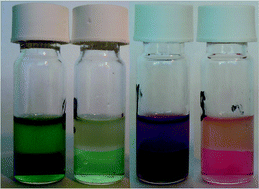Highly efficient separation of rare earths from nickel and cobalt by solvent extraction with the ionic liquid trihexyl(tetradecyl)phosphonium nitrate: a process relevant to the recycling of rare earths from permanent magnets and nickel metal hydride batteries
Abstract
A solvent extraction process with the ionic liquid trihexyl(tetradecyl)phosphonium nitrate has been developed to extract rare earths and separate them from nickel or cobalt. The process is environmentally friendlier than traditional solvent extraction processes, since no volatile and flammable diluents have to be used. Compared to conventional ionic liquid metal extraction systems, the advantage of using the new ionic liquid is that expensive and persistent fluorinated ionic liquids can be avoided. The ionic liquid can be prepared by a simple metathesis reaction from the commercially available ionic liquid trihexyl(tetradecyl)phosphonium chloride (Cyphos IL 101). The extraction is facilitated by an inner salting-out effect of a highly concentrated metal nitrate aqueous phase. Feed solutions containing 164 g L−1 cobalt(II) and 84 g L−1 samarium(III), or 251 g L−1 nickel(II) and 61 g L−1 lanthanum(III) were tested. Percentage extractions of more than 99% were obtained for the rare earths and after a subsequent scrubbing step, the purity of the rare earth in the loaded ionic liquid phase was 99.9%. Complete stripping and regeneration of the ionic liquid could be performed using no chemicals other than pure water. Special attention was paid to the viscosity of the loaded ionic liquid phase and the kinetics of the extraction process, because the high viscosity and the slow mass transfer are the reasons why non-fluorinated ionic liquids have always been diluted in the past with conventional hydrophobic organic solvents such as kerosene, toluene or chloroform. The extraction mechanism of the rare earths samarium and lanthanum was studied and it was shown that different anionic complexes are formed. Lanthanum(III) is extracted at maximal loading via the hexakis anionic complex [La(NO3)6]3−, whereas samarium(III) is extracted at maximal loading via the pentakis anionic complex [Sm(NO3)5]2−. The difference in electrical charge of the anions has a pronounced effect on the viscosity of the ionic liquid phases. The separation of lanthanum and samarium from nickel or cobalt, out of highly concentrated metal salt solutions by solvent extraction, is of importance for the recycling samarium–cobalt permanent magnets or nickel metal hydride (NiMH) batteries.


 Please wait while we load your content...
Please wait while we load your content...